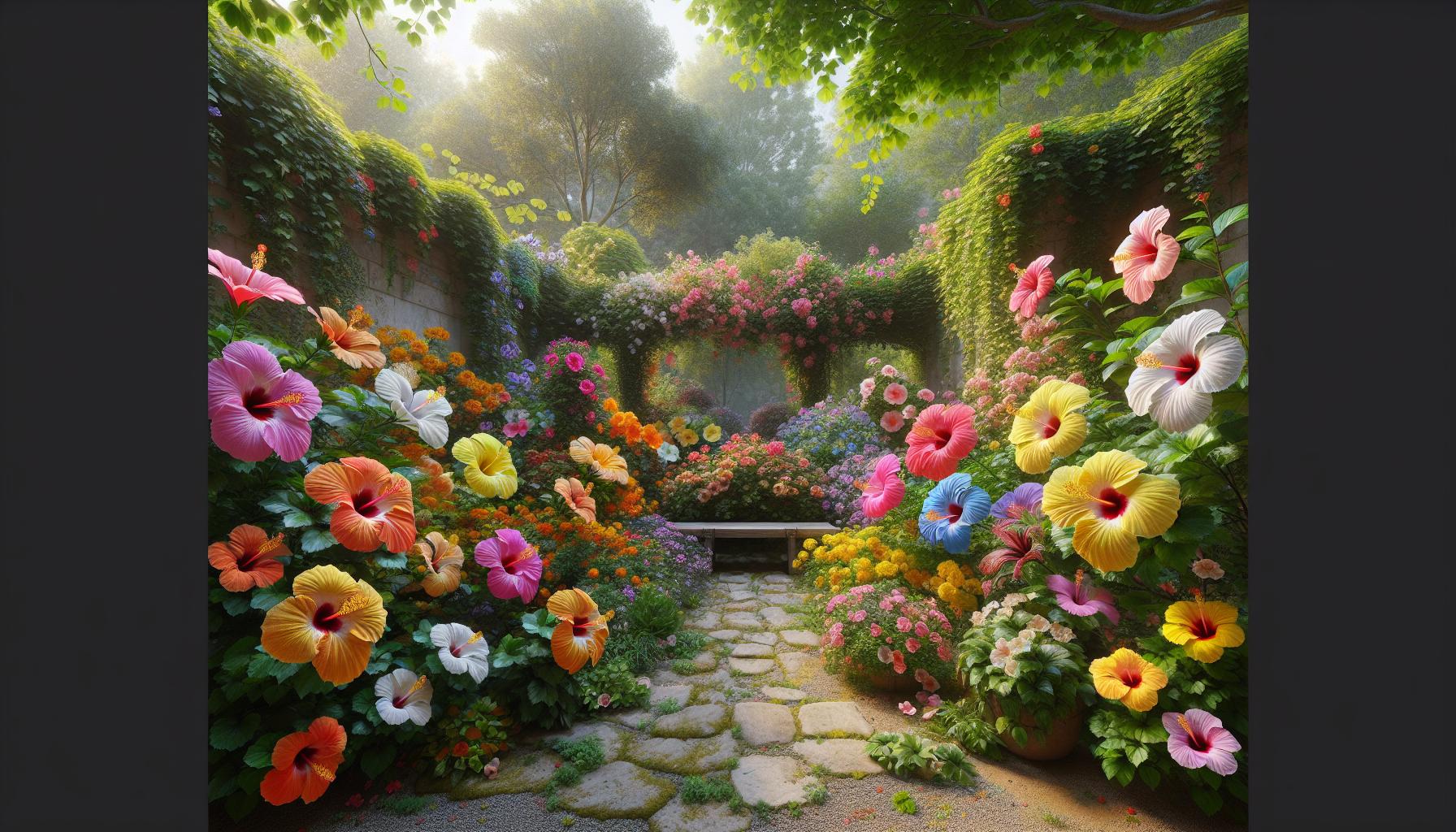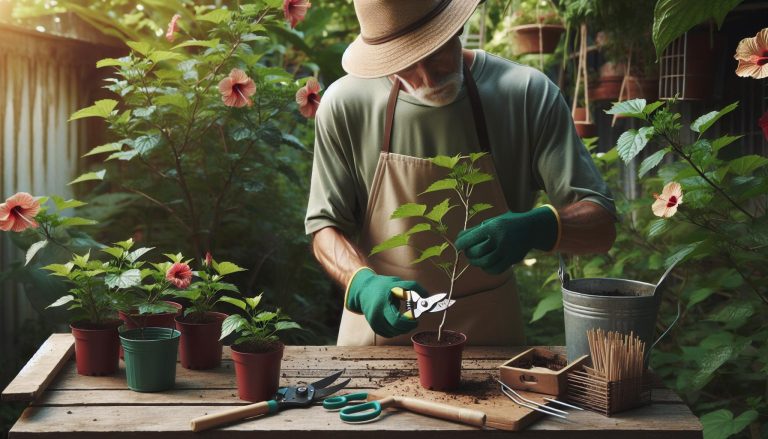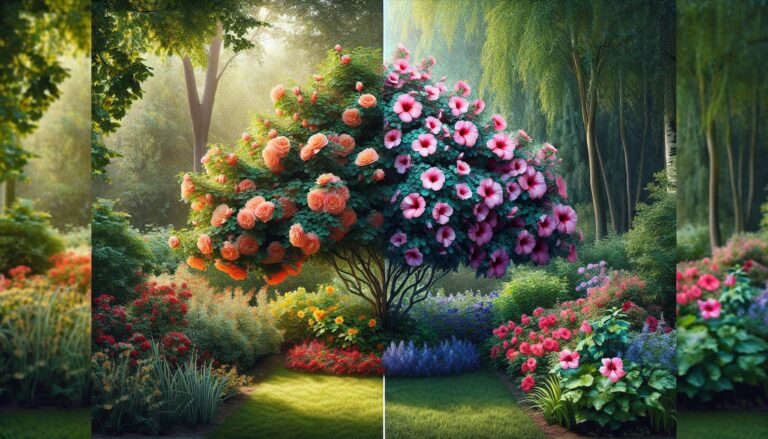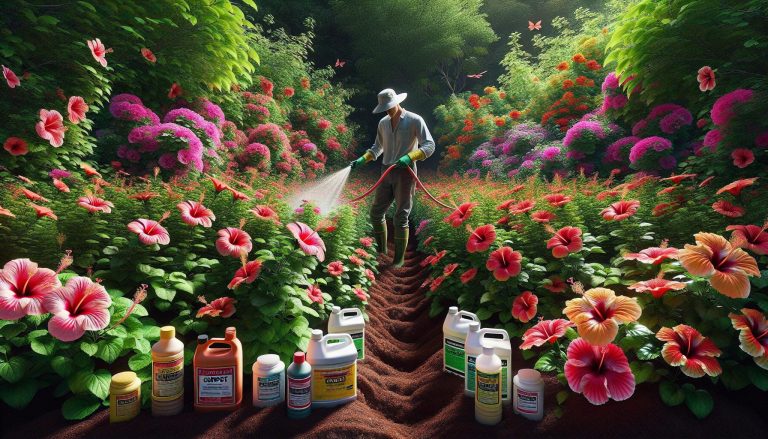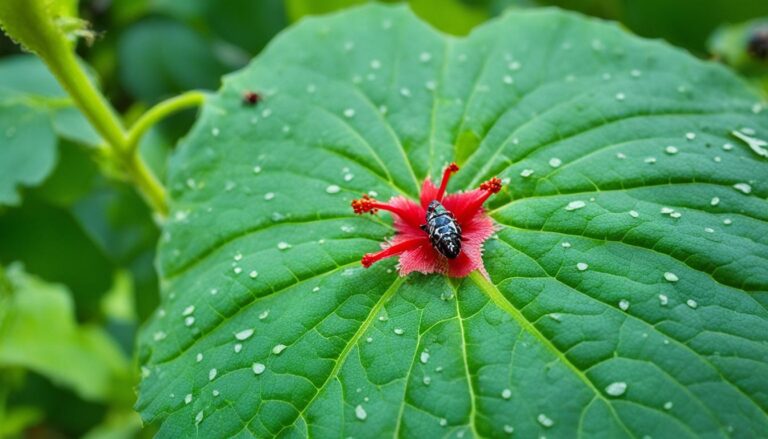Hibiscus Varieties (50 Stunning Options for Your Garden)
As an avid gardener for the past 7 years, I’ve developed a special affection for hibiscus plants. With their stunning blooms in a rainbow of colors and variety of shapes and sizes, it’s no wonder hibiscus are beloved by so many. In my own garden, I’ve cultivated quite a collection of these tropical beauties.
Hibiscus isn’t just one flower – it’s a diverse genus containing several hundred species! While we can’t cover them all here, I’m excited to introduce you to 50 of the most interesting and appealing hibiscus varieties.
Whether you’re a seasoned green thumb or a budding novice, I think you’ll enjoy learning more about these spectacular plants. Let’s dive in!
Hardy Hibiscus
First, let’s explore the hardy hibiscus – varieties that can tolerate a bit of cold in zones 4-9. Unlike their tropical cousins, these plants die back to the ground each winter but re-emerge in the spring.
Hibiscus moscheutos (Common Rose Mallow):
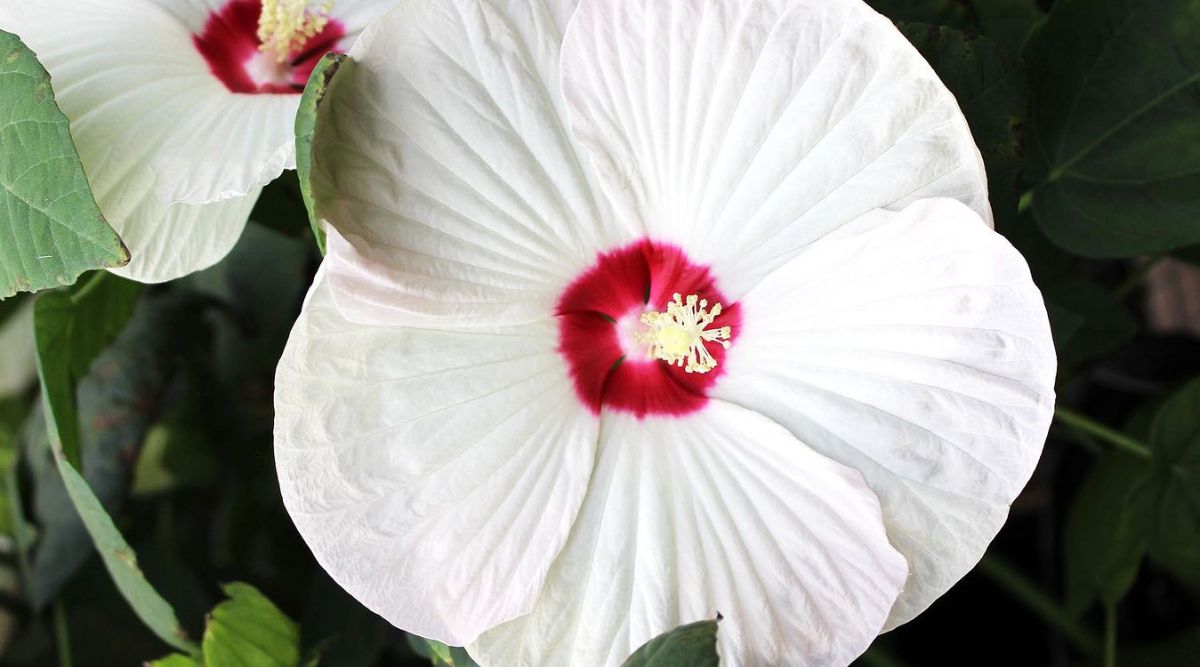
Large 10″ flowers in white, pink, or red. Thrives in moist soils and full sun. Perfect for the back of a border.
-
- Appearance: Large, showy flowers up to 10″ across in white, pink, or red
- Preferred Conditions: Moist, well-draining soil; full sun
- USDA Zones: 4-9
- Care Instructions:
- Sunlight: Full sun
- Watering: Keep consistently moist
- Interesting Fact: Attracts butterflies and hummingbirds
Hibiscus coccineus (Texas Star):

Stunning 3-5″ red blooms with a central white star. Loves wet ground, even brackish water. Attracts butterflies and hummingbirds.
-
- Appearance: Bright red flowers with white star-shaped centers, 3-5″ wide
- Preferred Conditions: Wet soil or even standing water; full sun
- USDA Zones: 6-9
- Care Instructions:
- Sunlight: Full sun
- Watering: Keep very moist to wet
- Interesting Fact: Can tolerate brackish water
Hibiscus laevis (Halberdleaf Rosemallow):
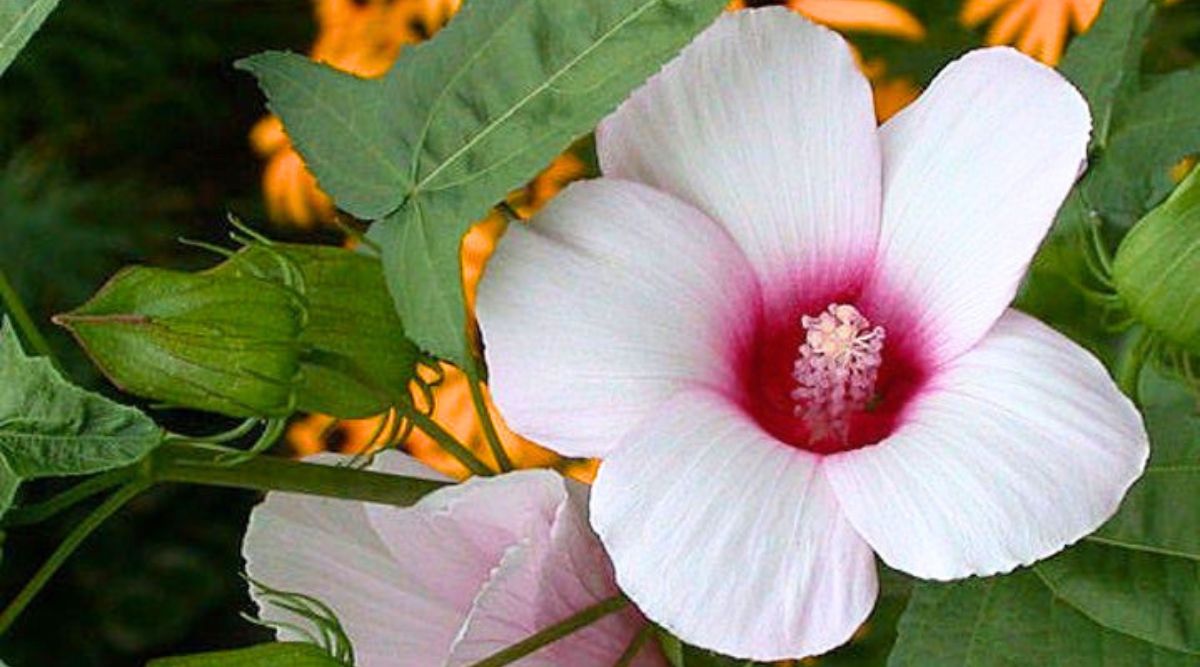
Unique foliage shaped like a halberd. Pale pink 4-6″ flowers with a burgundy center. Native to wetlands and stream banks.
-
- Appearance: Pale pink flowers 4-6″ wide with dark red centers; halberd-shaped leaves
- Preferred Conditions: Moist to wet soils; full sun
- USDA Zones: 5-9
- Care Instructions:
- Sunlight: Full sun
- Watering: Keep consistently moist
- Interesting Fact: Unique leaf shape resembles a halberd weapon
Hibiscus dasycalyx (Neches River Rosemallow):
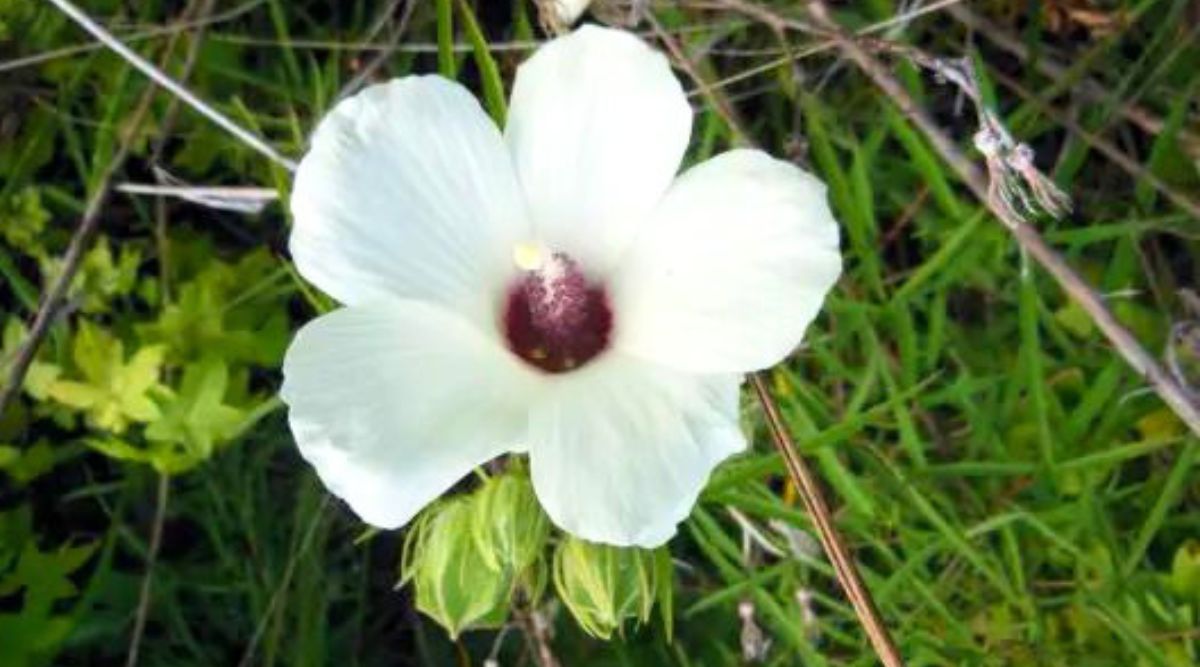
Extremely rare species native only to Texas. Delicate 3-4″ white to pink-tinged blooms with a deep red eye. Threatened by habitat loss.
-
- Appearance: White to pale pink flowers 3-4″ across with contrasting deep red centers
- Preferred Conditions: Moist, acidic soils along rivers; partial shade
- USDA Zones: 8-9
- Care Instructions:
- Sunlight: Partial shade
- Watering: Keep moist but not soggy
- Interesting Fact: Critically endangered species found only in a few Texas counties
Hibiscus grandiflorus (Swamp Rose Mallow):
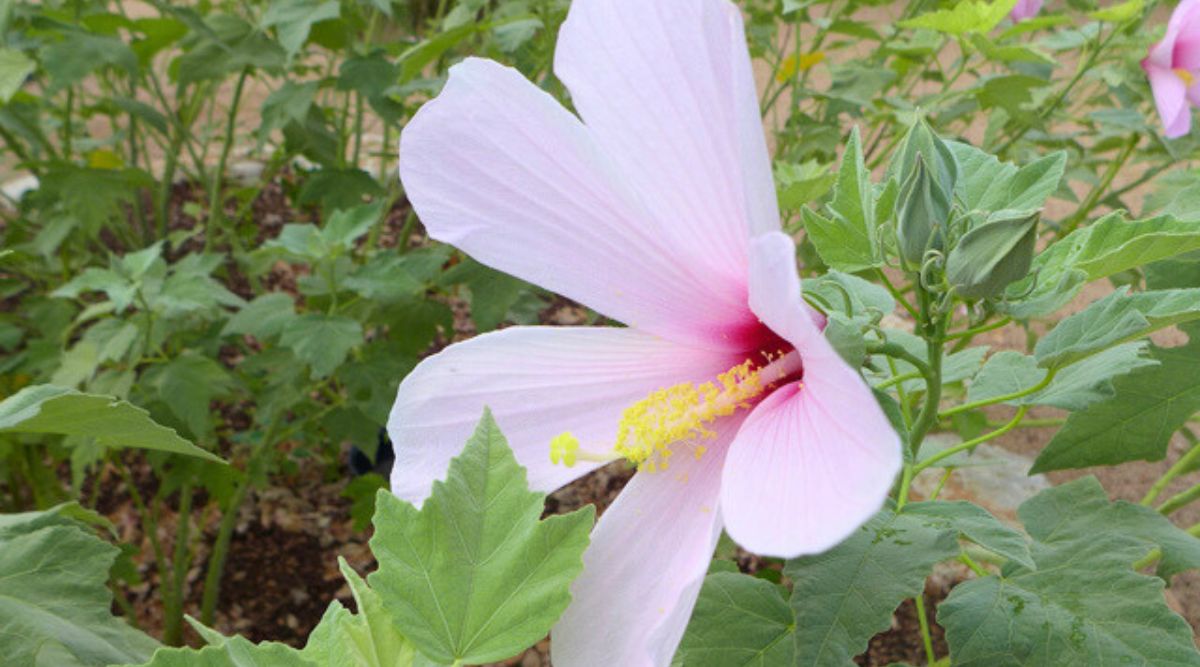
An impressive 10-12″ across, the flowers are light pink with a deep red eye. Needs consistently moist to wet soil.
-
- Appearance: Massive soft pink flowers 10-12″ wide with rich red centers
- Preferred Conditions: Wet, swampy soils high in organic matter; full sun
- USDA Zones: 6-9
- Care Instructions:
- Sunlight: Full sun
- Watering: Keep wet, even with standing water
- Interesting Fact: One of the largest hibiscus flowers
Exotic Tropical Hibiscus
For a lush, exotic look, tropical hibiscus is unmatched. Usually grown as potted plants that overwinter indoors, these tender shrubs enchant with an endless display of huge, flamboyant flowers. Here are some of the most captivating cultivars:
Hibiscus rosa-sinensis ‘Painted Lady’:
Gorgeous double blooms swirl with shades of orange, yellow, and pink, resembling a tropical sunset.
-
- Appearance: Large double flowers in vivid swirls of orange, yellow, and pink
- Preferred Conditions: Rich, well-draining soil; bright light
- USDA Zones: 9-11
- Care Instructions:
- Sunlight: Bright indirect light or some direct sun
- Watering: Allow to dry slightly between watering
- Interesting Fact: Brilliant colors seem painted on by an artist
Hibiscus rosa-sinensis ‘Black Dragon’:
Dramatic and moody, with deep burgundy-red petals that are nearly black towards the center.
-
- Appearance: Bold dark red to burgundy petals, almost black at the center
- Preferred Conditions: Well-draining potting mix; bright light
- USDA Zones: 10-11
- Care Instructions:
- Sunlight: Bright indirect light
- Watering: Keep evenly moist
- Interesting Fact: Darkest red hibiscus cultivar
Hibiscus rosa-sinensis ‘Erin Rachel’:
Vibrant tangerine-orange flowers absolutely glow against the glossy green leaves. A hummingbird magnet!
-
- Appearance: Intense orange flowers that seem to glow, contrasting with shiny foliage
- Preferred Conditions: Fertile potting mix, lots of bright light
- USDA Zones: 9-11
- Care Instructions:
- Sunlight: Bright light, some direct sun
- Watering: Maintain consistent moisture
- Interesting Fact: Attracts hordes of hummingbirds
Hibiscus rosa-sinensis ‘Aphrodite’:
Luscious, large pink double blooms are fit for a goddess. Prolific and long-blooming.
-
- Appearance: Big, fluffy double flowers in clear medium pink
- Preferred Conditions: Organically rich potting mix, bright indirect light
- USDA Zones: 9-11
- Care Instructions:
- Sunlight: Bright indirect light
- Watering: Water when top inch of soil is dry
- Interesting Fact: Named for the Greek goddess of love and beauty
Hibiscus schizopetalus (Fringed Hibiscus):
Exotic pendulous coral-red flowers with deeply fringed, recurved petals. The striking blooms can reach 6″ long!
-
- Appearance: Hanging red flowers up to 6″ long with frilly, divided petals
- Preferred Conditions: Rich, well-draining potting mix; filtered sunlight
- USDA Zones: 10-11
- Care Instructions:
- Sunlight: Bright indirect light
- Watering: Allow to dry somewhat between watering
- Interesting Fact: Extremely unusual petal shape for a hibiscus
Perennial Hibiscus
These herbaceous perennials bring a tropical flair to temperate gardens. Emerging from the ground in late spring, they produce a spectacular floral show through the summer before dying back in the fall.
Hibiscus ‘Summerific Cherry Choco Latte’:
Huge 8-9″ flowers in white with deep pink veining and a red eye. Forms an upright mound of deep green foliage.
-
- Appearance: Large white flowers with pink veins and red centers, 8-9″ wide
- Preferred Conditions: Moist, well-draining soil; full sun
- USDA Zones: 4-9
- Care Instructions:
- Sunlight: Full sun
- Watering: Keep consistently moist
- Interesting Fact: Compact size is perfect for smaller gardens
Hibiscus ‘Airbrush Effect’:
Stunning 8-10″ lavender-pink flowers are tie-dyed with splatters and streaks of darker pink and red. Compact habit.
-
- Appearance: Lavender-pink flowers 8-10″ across, speckled and streaked with darker colors
- Preferred Conditions: Humus-rich, moist soil; full sun
- USDA Zones: 4-9
- Care Instructions:
- Sunlight: Full sun
- Watering: Maintain even moisture
- Interesting Fact: No two flowers are exactly alike
Hibiscus ‘Midnight Marvel’:
Striking black-purple maple-like foliage and 9″ true red flowers. Dramatic specimen plant.
-
- Appearance: Bright red 9″ flowers contrasting with deep purple, almost black leaves
- Preferred Conditions: Moist, organically rich soil; full sun
- USDA Zones: 4-9
- Care Instructions:
- Sunlight: Full sun
- Watering: Keep moist but well-drained
- Interesting Fact: Foliage color intensifies in full sun
Hibiscus ‘Starry Starry Night’:
Near-black foliage is dotted with white stars and accented by 7-8″ pale pink flowers with darker edges. Very unique.
-
- Appearance: Light pink flowers 7-8″ wide with deeper pink edges; black leaves flecked with white
- Preferred Conditions: Rich, moisture-retentive but well-draining soil; full sun
- USDA Zones: 4-9
- Care Instructions:
- Sunlight: Full sun for best leaf color
- Watering: Keep evenly moist
- Interesting Fact: Variegation on the leaves resembles a starry night sky
Hibiscus ‘Vintage Wine’:
Huge 7″ red flowers are edged in white, making them look delightfully hand-painted. Appears to be glowing from within.
-
- Appearance: Deep red 7″ blooms with crisp white edges that seem to glow
- Preferred Conditions: Fertile, moist soil; full sun
- USDA Zones: 4-9
- Care Instructions:
- Sunlight: Full sun
- Watering: Maintain consistent moisture
- Interesting Fact: Looks like an antique hand-painted design
Shrub Hibiscus
These multi-stemmed woody shrubs are adorned with prolific blooms all summer. Most are only hardy in zones 9-10 but can be grown as dieback perennials or potted plants in colder areas.
Hibiscus mutabilis (Confederate Rose):
Large, showy double flowers change color from white to pink to deep red over several days. Fast-growing shrub.
-
- Appearance: Double blooms 4-6″ across that change from white to pink to red with age
- Preferred Conditions: Organically rich, well-draining soil; full sun
- USDA Zones: 7-11
- Care Instructions:
- Sunlight: Full sun
- Watering: Regular moisture, drought tolerant once established
- Interesting Fact: Flowers last longer when picked as buds
Hibiscus syriacus (Rose of Sharon):
Profuse single or double flowers in shades of white, pink, red, purple, or blue from summer to fall. Extremely cold-hardy.
-
- Appearance: Single or double flowers 2-4″ wide in a range of colors; often with a contrasting eye
- Preferred Conditions: Adaptable to most soils; full sun to light shade
- USDA Zones: 5-9
- Care Instructions:
- Sunlight: Full sun to light shade
- Watering: Moderately drought tolerant
- Interesting Fact: National flower of South Korea
Hibiscus paramutabilis (Pink Confederate Rose):
Similar to the Confederate Rose but with larger, single pink flowers that don’t change color.
-
- Appearance: Large, flared pink flowers up to 8″ across
- Preferred Conditions: Fertile, well-draining soil; full sun
- USDA Zones: 8-11
- Care Instructions:
- Sunlight: Full sun
- Watering: Keep evenly moist
- Interesting Fact: Seedpods are decorative in dried arrangements
Hibiscus ‘Hefei’:
Lacy purple foliage provides the perfect backdrop for 6″ lavender-blue flowers. Unique color combo.
-
- Appearance: Lavender-blue single blooms 6″ wide; deeply cut purple leaves
- Preferred Conditions: Well-draining potting mix; full to part sun
- USDA Zones: 9-11
- Care Instructions:
- Sunlight: Full sun to light shade
- Watering: Allow surface to dry between watering
- Interesting Fact: Rarely seen color for a hibiscus flower
Hibiscus tiliaceus (Sea Hibiscus):
Bright yellow blooms with a maroon center that fade to orange-apricot. Heat and salt tolerant.
-
- Appearance: Yellow flowers 4″ across with dark red centers, fading to apricot
- Preferred Conditions: Rich, well-draining soil; full to part sun
- USDA Zones: 9-11
- Care Instructions:
- Sunlight: Full sun to part shade
- Watering: Drought tolerant once established
- Interesting Fact: Grows very quickly, up to 10 feet per year
Species Hibiscus
These wild hibiscus species are the ancestors of the flashy cultivars. While the flowers tend to be smaller and simpler, they still possess an untamed beauty. Many are endangered in their native habitats.
Hibiscus aculeatus (Comfortroot):
Creamy yellow flowers with a deep red eye bloom on this Florida native. Prickly stems and leaves.
-
- Appearance: Pale yellow 3-4″ blooms with contrasting dark red centers
- Preferred Conditions: Moist, sandy soils; full sun
- USDA Zones: 8-10
- Care Instructions:
- Sunlight: Full sun
- Watering: Keep moist but well-drained
- Interesting Fact: Roots were chewed by Native Americans to relieve toothache
Hibiscus clayi (Clay’s Hibiscus):
A rare species from Hawaii with delicate coral-pink flowers and a white stigma pad. Grows as a small tree.
-
- Appearance: Coral-pink 2-3″ flowers with prominent white stigmas
- Preferred Conditions: Tropical environment; rich, well-draining soil; bright light
- USDA Zones: 10-11
- Care Instructions:
- Sunlight: Bright indirect light or morning sun
- Watering: Water regularly, allowing brief drying between
- Interesting Fact: Critically endangered with fewer than 200 individuals left in the wild
Hibiscus hamabo (Hamabo):
Yellow flowers with a red center bloom in summer on this Japanese species. Salt and wind tolerant.
-
- Appearance: Sunny yellow 3-4″ flowers with a red eye, produced abundantly
- Preferred Conditions: Well-draining sandy soil; full sun
- USDA Zones: 8-10
- Care Instructions:
- Sunlight: Full sun
- Watering: Moderately drought tolerant
- Interesting Fact: Grows naturally along the coast and estuaries
Hibiscus arnottianus (Kokio keokeo):
Graceful white flowers distinguish this Hawaiian endemic. Grows as a tall shrub or small tree.
-
- Appearance: Pure white 3-5″ flowers with pale yellow stamens
- Preferred Conditions: Tropical environment; rich, moist soil; filtered light
- USDA Zones: 10-11
- Care Instructions:
- Sunlight: Bright indirect light
- Watering: Maintain even moisture
- Interesting Fact: One of the few white-flowered hibiscus species
Hibiscus calyphyllus (Lemonyellow Rosemallow):
Cheerful pale lemon flowers adorn this African species in the cool dry season. Fast-growing shrub.
-
- Appearance: Soft yellow blooms 3-4″ wide with a slight pink blush
- Preferred Conditions: Tropical environment; well-draining soil; full to part sun
- USDA Zones: 9-11
- Care Instructions:
- Sunlight: Full sun to part shade
- Watering: Allow to dry a bit between watering
- Interesting Fact: Goes dormant and drops leaves in hot dry season
Edible Hibiscus
Several species of hibiscus are prized for their culinary and medicinal uses. These plants will feed both body and soul with their wholesome beauty.
Hibiscus sabdariffa (Roselle):
Huge, tart red calyces are harvested for tea, jams, and jellies. Pale yellow flowers attract beneficial insects.
-
- Appearance: Light yellow 3″ flowers followed by plump, bright red calyces
- Preferred Conditions: Rich, well-draining loamy soil; full sun
- USDA Zones: 9-11 (grow as an annual elsewhere)
- Care Instructions:
- Sunlight: Full sun
- Watering: Regular moisture, tolerates some dry spells
- Interesting Fact: Makes a tangy tea loaded with vitamin C
Hibiscus acetosella (Cranberry Hibiscus):
Deep burgundy, maple-like leaves are tart and tangy. Pretty pink flowers are a bonus.
-
- Appearance: Copper-burgundy leaves with pink veins; soft pink 2-3″ flowers
- Preferred Conditions: Organically rich soil; full to part sun; consistent moisture
- USDA Zones: 8-11
- Care Instructions:
- Sunlight: Full sun to part shade
- Watering: Keep evenly moist
- Interesting Fact: Leaves make a tart, bright pink herbal tea
Hibiscus cannabinus (Kenaf):
Towering plants bear pretty pale yellow flowers with a burgundy eye. Grown for its edible leaves and strong fibers.
-
- Appearance: Light yellow 3-4″ blooms with dark red centers on tall stalks
- Preferred Conditions: Rich, moist loamy soil; full sun
- USDA Zones: Grown as an annual
- Care Instructions:
- Sunlight: Full sun
- Watering: Regular moisture, tolerates some dry spells
- Interesting Fact: One of the world’s oldest fiber crops
Abelmoschus esculentus (Okra):
Closely related to hibiscus with similarly showy ornamental flowers. Pods are a staple in Southern cooking.
-
- Appearance: Large tropical leaves; pretty cream, yellow, or pink flowers with dark eyes
- Preferred Conditions: Rich, loamy soil; full sun; consistent moisture
- USDA Zones: Grown as an annual
- Care Instructions:
- Sunlight: Full sun
- Watering: Keep consistently moist, not soggy
- Interesting Fact: “Okra” comes from “nkru” meaning “plant” in the Ashanti language of West Africa
Abelmoschus moschatus (Musk Mallow):
Musky-scented seeds are used in perfumes and as a flavoring. Charming pink flowers with a dark eye.
-
- Appearance: Pink 2-3″ flowers with dark red centers; very aromatic
- Preferred Conditions: Humus-rich, moist but well-draining soil; full to part sun
- USDA Zones: 9-11
- Care Instructions:
- Sunlight: Full sun to light shade
- Watering: Regular moisture
- Interesting Fact: Seeds have a musk-like aroma used in perfumery
Ornamental Foliage Hibiscus
While flowers are the main draw for most hibiscus, some varieties are grown primarily for their dazzling leaves. These plants provide color and interest even when not in bloom.
Hibiscus acetosella ‘Maple Sugar’:
Palmate, deeply lobed leaves in rich shades of red and burgundy resemble decorative maple leaves.
-
- Appearance: Deeply cut burgundy leaves shaped like fancy maple leaves; small pink flowers
- Preferred Conditions: Fertile, well-draining soil; full to part sun
- USDA Zones: 8-11
- Care Instructions:
- Sunlight: Full sun to part shade
- Watering: Maintain consistent moisture
- Interesting Fact: Foliage color is boldest in cooler weather
Hibiscus acetosella ‘Haight Ashbury’:
Trippy tie-dyed foliage in swirls of green, cream, and hot pink steals the show. Cute reddish-pink flowers.
-
- Appearance: Variegated leaves splashed with green, cream, and bright pink; small pinkish-red flowers
- Preferred Conditions: Humus-rich, evenly moist soil; full to part sun
- USDA Zones: 8-11
- Care Instructions:
- Sunlight: Full sun to light shade
- Watering: Keep consistently moist
- Interesting Fact: Color is most vivid in part sun
Hibiscus moscheutos ‘Midnight Marvel’:
Enormous near-black maple-shaped leaves provide striking contrast to scarlet flowers. Supersized specimen plant.
-
- Appearance: Huge purple-black lobed leaves; bright red 9-10″ flowers
- Preferred Conditions: Rich, moist soil; full sun
- USDA Zones: 4-9
- Care Instructions:
- Sunlight: Full sun for darkest foliage color
- Watering: Maintain even moisture
- Interesting Fact: Flowers develop a white starburst pattern as they age
Hibiscus mutabilis ‘Versicolor’:
Mottled and speckled leaves streaked with cream and pink look hand-painted. Double flowers fade through multiple colors.
-
- Appearance: Creamy green leaves abundantly flecked with pink; double pink-to-red 4-5″ blooms
- Preferred Conditions: Fertile, well-draining soil; full to part sun
- USDA Zones: 7-11
- Care Instructions:
- Sunlight: Full sun to part shade
- Watering: Regular moisture
- Interesting Fact: Blooms change color from white to pink to red over 3 days
Hibiscus rhodanthus (Mandrinette Hibiscus):
Maple-shaped olive green leaves with red veining and margins. Dark red flowers shaped like a partially closed umbrella.
-
- Appearance: Dark green, red-veined palmate leaves; unusual bowl-shaped dark red flowers
- Preferred Conditions: Rich, well-draining soil; bright light
- USDA Zones: 9-11
- Care Instructions:
- Sunlight: Bright, indirect light
- Watering: Allow the surface to dry between watering
- Interesting Fact: Native to mountainous regions of eastern Madagascar
Compact Hibiscus
If you’re short on space but still crave the beauty of hibiscus, try one of these petite varieties perfect for small gardens and containers.
Hibiscus rosa-sinensis ‘Petit Orange’:
Diminutive size but full-sized 3-4″ bright orange flowers absolutely smother this little charmer. Great for bonsai.
-
- Appearance: Compact, dense shrub covered in punchy orange 3-4″ flowers
- Preferred Conditions: Well-draining potting mix; bright light; protection from harsh sun
- USDA Zones: 9-11
- Care Instructions:
- Sunlight: Bright indirect light or morning sun
- Watering: Water when surface is dry
- Interesting Fact: Stays under 2 feet tall but blooms non-stop
Hibiscus schizopetalus ‘Dwarf Coral’:
Unique fringed coral-red petals dangle from this petite cultivar. Eye-catching and unusual.
-
- Appearance: Deeply divided coral-red petals with curled edges; prolific flowers on compact plant
- Preferred Conditions: Organically rich potting mix; bright light with some direct sun
- USDA Zones: 10-11
- Care Instructions:
- Sunlight: Bright direct morning sun to indirect light
- Watering: Allow soil to dry slightly between watering
- Interesting Fact: Mature height only 2-3 feet
Hibiscus ‘Cinnamon Grappa’:
Masses of petite pale pink flowers with a rich red eye top neat, compact foliage all summer. Great for borders and containers.
-
- Appearance: Soft pink 3-4″ flowers with dark red centers abundantly produced on a compact plant
- Preferred Conditions: Moist, well-draining soil; full sun
- USDA Zones: 4-9
- Care Instructions:
- Sunlight: Full sun
- Watering: Keep evenly moist
- Interesting Fact: Stays under 4 feet tall and wide
Hibiscus rosa-sinensis ‘Mini Pearl’:
Precious, ruffled lilac-pink flowers with streaky dark red centers. Compact, tidy habit.
-
- Appearance: Small, frilly lavender-pink blooms with bold red streaks radiating from the center
- Preferred Conditions: Rich, well-draining potting mix; very bright light
- USDA Zones: 9-11
- Care Instructions:
- Sunlight: Bright light with some direct sun
- Watering: Maintain consistent moisture
- Interesting Fact: Mature height only 18-24 inches
Hibiscus trionum (Flower-of-an-Hour):
Diminutive species bearing fleeting but charming 1-2″ cream flowers with a purple-black center. Reseeds readily.
-
- Appearance: Small pale yellow 1-2″ blooms with dark purple eyes; only last a day
- Preferred Conditions: Well-draining soil; full sun; heat and drought tolerant
- USDA Zones: 2-11
- Care Instructions:
- Sunlight: Full sun
- Watering: Minimal once established
- Interesting Fact: Each flower only blooms for a few hours before wilting
Climbing Hibiscus
A few species of hibiscus have taken to the trees, developing climbing or scandent habits. These vigorous vines can quickly cover a trellis or arbor in tropical splendor.
Hibiscus paramutabilis x syriacus (Lohengrin Hibiscus):
Lavender-pink flowers up to 10 inches across adorn this vigorous climber. Puts on a jaw-dropping display.
-
- Appearance: Enormous lavender-pink single flowers with reddish centers; climbing stems
- Preferred Conditions: Moist, humus-rich soil; full sun; sturdy support structure
- USDA Zones: 6-9
- Care Instructions:
- Sunlight: Full sun
- Watering: Regular moisture
- Interesting Fact: Blooms reach the size of dinner plates
Hibiscus rosa-sinensis ‘Climbing Red’:
Brilliant red flowers and long, climbing branches make this a dramatic choice for a trellis or fence. Hummingbird favorite.
-
- Appearance: Clmbing stems bear glossy foliage and 5-6″ vivid red flowers
- Preferred Conditions: Rich, well-draining potting mix; full to part sun; support structure
- USDA Zones: 9-11
- Care Instructions:
- Sunlight: Full sun to light shade
- Watering: Maintain even moisture
- Interesting Fact: Can climb 10-12 feet in frost-free areas
Hibiscus diversifolius (Swamp Hibiscus):
Scandent species that sprawls and climbs through supporting vegetation. Primrose yellow flowers with a burgundy center.
-
- Appearance: Soft yellow 4-5″ wide flowers with contrasting dark red eyes; climbing or sprawling stems
- Preferred Conditions: Consistently moist to wet soil; full sun
- USDA Zones: 8-11
- Care Instructions:
- Sunlight: Full sun
- Watering: Keep moist to wet
- Interesting Fact: Tolerates soggy soils and shallow standing water
Hibiscus macrophyllus (Largeleaf Rosemallow):
Truly huge 12″+ dinner plate flowers in pale yellow with a deep red eye. Scandent stems clamber up trees.
-
- Appearance: Gigantic light yellow flowers with dark red centers up to 1 foot across; climbing habit
- Preferred Conditions: Rich, moist but well-draining soil; bright light; support to climb
- USDA Zones: 9-11
- Care Instructions:
- Sunlight: Bright indirect light or filtered sun
- Watering: Maintain consistently moist soil
- Interesting Fact: One of the largest flowers in the genus
Hibiscus mutabilis ‘Flore Pleno’ (Double Dixie Rosemallow):
Large, frilly double flowers change colors from white to pink to red. Shrubby climber.
-
- Appearance: Fluffy double flowers 4-5″ across that fade from white to pink to deep red with age
- Preferred Conditions: Fertile, moist but well-draining soil; full sun; climbing support
- USDA Zones: 7-11
- Care Instructions:
- Sunlight: Full sun
- Watering: Consistent moisture
- Interesting Fact: Flowers last longer when picked before fully open
Novelty Hibiscus
Some hibiscus pushes the boundaries of the usual form, delighting us with unexpected shapes, textures, or habits. These unique varieties are sure to be a conversation starter.
Hibiscus trionum ‘Simply Love’:
Enchanting pendulous white and burgundy flowers have a charming crepe-paper texture. Compact, heavily blooming plant.
-
- Appearance: Delicate, drooping white flowers with dark burgundy centers and a crinkled texture
- Preferred Conditions: Well-draining soil; full sun; tolerates heat and drought
- USDA Zones: 2-11
- Care Instructions:
- Sunlight: Full sun
- Watering: Moderate, allow to dry between watering
- Interesting Fact: Flowers close up each afternoon
Hibiscus sabdariffa ‘Roselle Maple’:
Edible calyces and striking foliage with enormous, deeply lobed bright green leaves. Eye-catching and productive.
-
- Appearance: Huge, deeply cut bright green leaves resemble maple leaves; green and red edible calyces
- Preferred Conditions: Rich, moist but well-draining soil; full sun
- USDA Zones: 9-11 (grown as annual elsewhere)
- Care Instructions:
- Sunlight: Full sun
- Watering: Regular moisture
- Interesting Fact: All parts are edible – leaves, flowers, calyces
Hibiscus mutabilis ‘Ruffled Cloud’:
Semi-double flowers have ruffled, frilly petals for a carnation-like look. Flowers fade through multiple colors.
-
- Appearance: Fluffy white semi-double flowers with crinkled petals that age to pink and then red
- Preferred Conditions: Fertile, moist soil; full sun; benefits from support
- USDA Zones: 7-11
- Care Instructions:
- Sunlight: Full sun
- Watering: Maintain even moisture
- Interesting Fact: Fading flowers create an ombré color effect
Hibiscus schizopetalus ‘Coral Reef’:
Unique coral-orange flowers with deeply divided, fringed petals resemble a fancy chandelier. Extremely eye-catching.
-
- Appearance: Exotic pendulous coral-orange blooms with lacy divided petals like a chandelier
- Preferred Conditions: Rich, well-draining potting mix; bright indirect light
- USDA Zones: 10-11
- Care Instructions:
- Sunlight: Bright indirect light
- Watering: Water when top inch of soil is dry
- Interesting Fact: Unusual flower form rarely seen in hibiscus
xArchibiscus archeri (Archer’s Hibiscus):
The intergeneric hybrid between Hibiscus and Abelmoschus with the vigor of okra and huge 6″ pink flowers with a dark eye.
-
- Appearance: Very large, showy light pink flowers with red centers on tall, robust plants
- Preferred Conditions: Organically rich, moist soil; full sun; heat loving
- USDA Zones: 9-11 (grown as annual elsewhere)
- Care Instructions:
- Sunlight: Full sun
- Watering: Regular moisture
- Interesting Fact: Fast-growing hybrid can reach 6-8 feet in a single season
Final Thoughts
I hope you’ve enjoyed learning about the incredible diversity of hibiscus varieties as much as I’ve enjoyed sharing my knowledge and passion for these beautiful plants.
Whether you prefer dainty dwarf varieties, enormous plate-sized blooms, or unique novelties, there’s truly a hibiscus for every taste and garden. The hardest part is choosing which ones to grow!
Happy planting!

